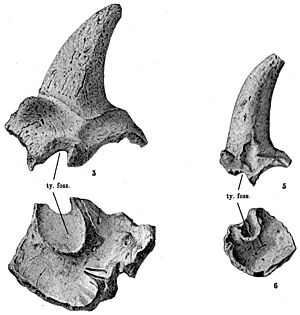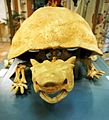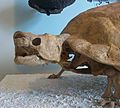Meiolania facts for kids
Quick facts for kids Meiolania |
|
|---|---|
 |
|
| Cast of a Meiolania platyceps skeleton, American Museum of Natural History | |
| Scientific classification |
|
| Kingdom: | Animalia |
| Phylum: | Chordata |
| Class: | Reptilia |
| Family: | †Meiolaniidae |
| Genus: | †Meiolania Owen, 1886 |
| Species | |
|
|
| Synonyms | |
|
|
Meiolania (pronounced My-oh-LAY-nee-ah) was a very unusual type of turtle that lived a long, long time ago. Its name means "small roamer," but some of these turtles were actually quite big! They are now extinct, meaning they no longer exist. Meiolania lived from about 15 million years ago (in the Middle Miocene epoch) until fairly recently, possibly even after humans appeared.
Contents
What Meiolania Looked Like
Meiolania had a very strange-looking skull. It had many bumps and horn-like parts. Two big horns stuck out sideways from its head. These horns were so large that the turtle could not pull its head all the way into its shell for protection.
Its tail was also special. It had armored rings around it, like a suit of armor. The end of the tail even had sharp, thorn-like spikes. Because of its armored body, Meiolania looked a bit like some dinosaurs called ankylosaurids or giant armadillos called glyptodonts.
There were different kinds of Meiolania. Two species lived on the Australian continent. One of these, an unnamed species, could grow up to 2 metres (6.6 ft) long. This made it the second-largest non-marine turtle ever known. Only Megalochelys atlas from Asia was bigger.
The smallest species was M. mackayi, found in New Caledonia. Its shell was about 70 centimetres (2.3 ft) long. Another species, M. platyceps, lived on Lord Howe Island.
How Meiolania Lived
Meiolania was a herbivore, meaning it ate plants. When its remains were first found near beaches, scientists thought it lived in the water. However, we now know that Meiolania mostly lived on land.
More recent studies suggest that these turtles lived near the coast. They might have lived in a way similar to the modern marine iguana. This means they could have spent time both on land and in shallow coastal waters.
Discovery and Different Species
The first Meiolania fossils were found in 1886 on Lord Howe Island. A scientist named Richard Owen gave them the names M. platyceps and M. minor. Later, M. minor was found to be the same as M. platyceps.
These were the first good fossils of this type of turtle. They helped scientists understand that other similar fossils, like those from Queensland (now known as Ninjemys oweni), were also from turtles, not lizards as first thought.
In 1925, a new species called M. mackayi was found on Walpole Island in New Caledonia. This species was smaller than M. platyceps. Other Meiolania fossils have also been found in places like the Pindai Caves and Tiga Island.
In 1992, M. brevicollis was discovered in northern Australia. This species had a flatter skull and different horn shapes compared to M. platyceps. Another large, unnamed species of Meiolania has also been found in Queensland, Australia.
Some turtle bones found in Vanuatu were thought to be a new Meiolania species, ?M. damelipi. However, after looking closely, scientists now think these bones might belong to a different type of tortoise. Similar bones have also been found in the Fijian archipelago.
Why Meiolania Disappeared
Scientists believe that the M. platyceps species on Lord Howe Island became extinct before humans arrived there. This likely happened because of rising sea levels after the last ice age. The rising water would have covered their coastal habitats, leaving them with nowhere to live.
Images for kids
-
The tail of Meiolania platyceps (AMNH 29076)
See also
 In Spanish: Meiolania para niños
In Spanish: Meiolania para niños






